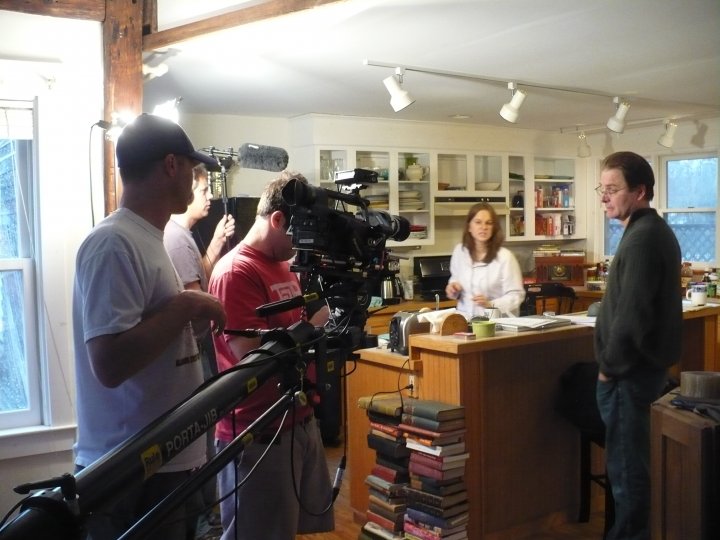
Acting, above all, is doing. I often use the baseball analogy. You can talk about hitting a 90 mile-an-hour fastball, you can read about hitting a 90 mile-an-hour fastball, you can imagine yourself hitting a 90 mile-an-hour fastball, but until one is coming at you and you swing the bat, you can’t possibly hit one. Every time the camera rolls on the set it’s a 90 mile-an-hour fastball. All the steps leading to that moment, as important as they are, must be set aside as the student takes the leap of courage to be in the moment and create.

Critical in conducting an acting course entirely online, is knowing that the student’s are not leveraging the technology to assist them. It does not serve them to use tools like their laptops for prompting when they will not have that support on stage or on a film set.
For assignments that seek to replicate live (theatrical settings) you may want to add this simple directive:
- Make sure we can see you entirely (from head-to-toe) and that you are well lit from the front.

By asking the students to shoot head-to-toe, you ensure they are far enough from the camera that any presence of script assistance can be seen, and they can’t read the text of a laptop they are using to film. Being well lit from the front ensures you can track their eye-line.
Auditioning IS acting. When you teach students to record themselves performing, you are teaching them a skill they will directly apply to their professional lives. In fact, very likely in the early years of their career, they will probably spend more time acting in an audition setting than in a performance before a paying audience. When we teach students to embrace the opportunity to act in auditions like they would any other acting opportunity, just for a different audience, we empower them to grow as artists in every environment.
Sharing actual requirements from the profession like the self-tape instructions from this prominent casting director, teaches students to start thinking of developing their work in a context and seeing format as a part of their expression rather than a series of restrictions inhibiting their creativity.
Self tape instructions (see below)

Students are often very concerned about showing their work. In order to prompt them to assemble their submissions in a way that provides them anonymity from the larger audience on YouTube or similar streaming service, I use these instructions. It also encourages them to submit links to their content rather than upload videos which many universities discourage because of hosting space. I also recommend that you do not download student’s videos directly as they may consume a great deal of drive space or accidentally contain viruses.
Anonymous Upload Instructions (see below)
AUDITION SELF TAPE INSTRUCTIONS
- Place the camera on a tripod or steady surface.
- A smartphone camera is fine, but always shoot horizontally.
- Make sure you are in a well-lit space without a distracting background.
- Cameras should NOT be set to record in 4K or 1080p. Your video clip files will be much too large.
- Go into settings of your camera or smartphone, and set video recording to something between 720p and 480p. Casting companies distribute auditions using Cast It Systems or Eco Cast on Breakdown Express, so those services will reduce any files to below 720p anyway.
- Sound must be loud and clear. Please be sure that the mic is directed toward the actor, and that the reader stands back so as not to overpower the actor’s voice.
- The actor’s voice should be heard clearly, and the reader’s should be quieter.
- Smaller rooms with furniture, rugs, etc. will reduce echo.
- Lighting should be good enough for us to see the color of the actor’s eyes. Use soft lighting if possible – avoid stark white light.
- Please tape auditions in front of a wall or backdrop that is in a solid, lighter color.
- Avoid having anything behind the actor that will distract the viewer’s eye such as furniture, pictures, windows, etc. A clean, solid wall or backdrop is best.
- Please do not use the black fade in and out of feature on your camera, or put titles/words on the screen at any time.
- The actor should slate their name, their height. You don’t’ need to say any other info.
- The slate should be framed like a headshot: head and shoulders, and then pull back for one, quick full body shot.
- Slates should be separate files, not part of the audition files. ONE SLATE FILE IS FINE.
- The reader should stand just to the right or left of the camera lens, and the actor should play to them, not into the camera lens.
- One good take. A second and third take is fine, if you feel strongly about showing a different creative choice.
Copywright @ CP Casting, LLC
YOUTUBE
UPLOAD INSTRUCTIONS
- Review the video when you are finished to make sure the audio and video both recorded.
- Upload the monologue to YouTube (or another streaming service that DOES NOT require me to sign up for an account).
- If you use YouTube you must save it as public (if you don’t mind people viewing it) or UNLISTED not private. Do not use your name or the name of the course in the title if you do not want others to view the video. It is better to use a nonsense work like BKAQURSTO as the title so the video does not accidentally come up in a search.
- Submit the text of this piece by attaching it using the buttons below or pasting it into the comments section.
- Clearly include the LINK to your video.
